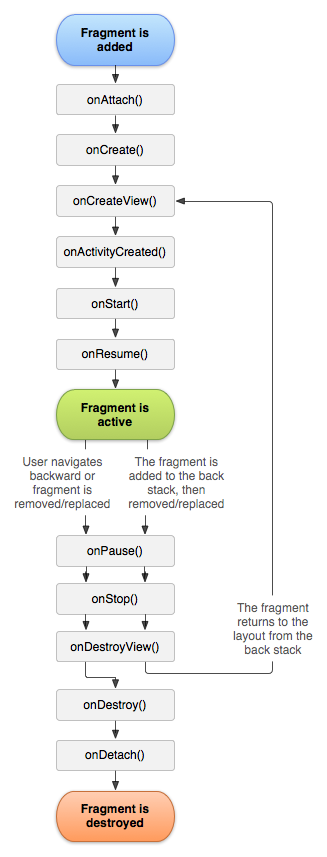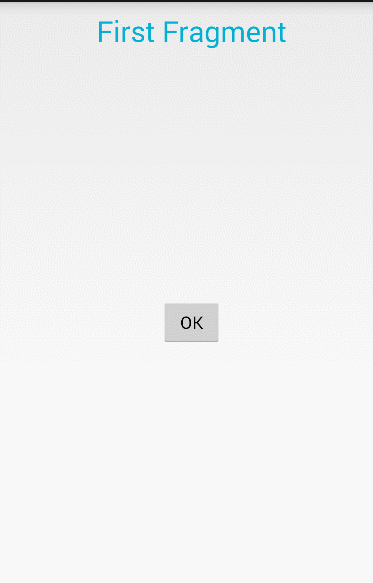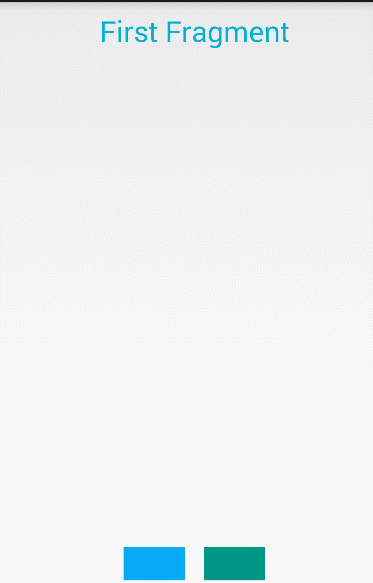1.Fragment的生命周期

Fragment是依赖与Activity而存在的,因此Activity的生命周期会直接影响到Fragment的生命周期。看图可以得知, Fragment比Activity的生命周期多了五个回调方法,其中onAttach()、onActivityCreated()、onDestroyView()和onDetach()都是与父Activity相关连的,OnCreateView则是用来创建Fragment自己的视图。
一、onAttach(); 是Fragment和Activity连接的时候调用。
二、onActivityCreated();是Activity的视图创建完毕后调用,也就是 Activity的oncreate()方法发回时调用。
三、onDstroyView();与onCreateView()相对应,当视图被销毁时调用。
四、onDetach();与Attach();相对应,Fragment与Activity断开时调用。
Fragment的命运与它所属的Activity是息息相关的.因此Fragment状态转换与它相对应的Activity状态转换也是密切相关的。所以当Activity处在前台拥有焦点时,这些Fragment也是活动的。当Activity被暂停或停止,Fragment也同样会暂停和停止。但是不管什么触发了Fragment的状态转换,都应该确保无缝的用户体验,当Fragment被暂停或或停止时保存所有的UI状态和持久化所有的数据是非常重要的.
2.创建静态的Fragment
静态的Fragment使用非常简单,我们可以把它当成一个普通的View控件来使用。
一、创建一个类继承Fragment并重写onCreateView来创建它的视图。
在这里我们使用两个Fragment演示,这里注意Fragment的导入包要统一,如果你想兼容3.0以下的请同意使用v4下的否则直接使用app下的,尽量不要混搭。
这个fragment我们不使用视图直接返回一个TextView;
public class FirstFragment extends Fragment {
@Override
public View onCreateView(LayoutInflater inflater, ViewGroup container, Bundle savedInstanceState) {
TextView tv = new TextView(getActivity());
tv.setText("First Fragment");
tv.setTextSize(30);
tv.setTextColor(Color.parseColor("#00b0d4"));
tv.setGravity(Gravity.CENTER);
return tv;
}
}我们是将布局插入Fragment,控件的点击事件也需要Fragment自己去完成。
public class SecondFragment extends Fragment {
private View mView;
private Button mButton;
@Override
public View onCreateView(LayoutInflater inflater, ViewGroup container, Bundle savedInstanceState) {
mView = inflater.inflate(R.layout.fragment_content, container, false);
mButton = (Button) mView.findViewById(R.id.fmt_btn_ok);
mButton.setOnClickListener(new OnClickListener() {
@Override
public void onClick(View v) {
Toast.makeText(getActivity(), "Second Fragment", Toast.LENGTH_SHORT).show();
}
});
return mView;
}
}接下来在Activity的布局中引用它。
<LinearLayout xmlns:android="http://schemas.android.com/apk/res/android"
xmlns:tools="http://schemas.android.com/tools"
android:layout_width="match_parent"
android:layout_height="match_parent"
android:orientation="vertical" >
<fragment
android:id="@+id/first_fragment"
android:name="com.example.stduyfragment.FirstFragment"
android:layout_width="match_parent"
android:layout_height="60dp" />
<fragment
android:id="@+id/second_fragment"
android:name="com.example.stduyfragment.SecondFragment"
android:layout_width="match_parent"
android:layout_height="match_parent" />
</LinearLayout>运行效果
3.动态的使用Fragment
如果想在运行时动态的切换Fragment或改变Fragment的布局,最好在布局文件中只定义父容器,通常我们使用FrameLayout。然后通过Fragment的事务来填充它。
接着上次的代码写。我们在中间布局使用FrameLayout,底部放置两个Button来切换Fragment;
<LinearLayout xmlns:android="http://schemas.android.com/apk/res/android"
xmlns:tools="http://schemas.android.com/tools"
android:layout_width="match_parent"
android:layout_height="match_parent"
android:orientation="vertical" >
<fragment
android:id="@+id/first_fragment"
android:name="com.example.stduyfragment.FirstFragment"
android:layout_width="match_parent"
android:layout_height="60dp" />
<FrameLayout
android:id="@+id/fmt_layout"
android:layout_width="match_parent"
android:layout_height="0dp"
android:layout_weight="1" />
<LinearLayout
android:layout_width="match_parent"
android:layout_height="40dp"
android:gravity="center_horizontal"
android:orientation="horizontal" >
<Button
android:id="@+id/mian_btn_one"
android:layout_width="wrap_content"
android:layout_height="wrap_content"
android:layout_marginBottom="5dp"
android:background="#03a9f4" />
<Button
android:id="@+id/mian_btn_two"
android:layout_width="wrap_content"
android:layout_height="wrap_content"
android:layout_marginBottom="5dp"
android:layout_marginLeft="20dp"
android:background="#009688" />
</LinearLayout>
</LinearLayout>然后在Activity进行管理Fragment
package com.example.stduyfragment;
import android.app.Activity;
import android.app.FragmentManager;
import android.app.FragmentTransaction;
import android.os.Bundle;
import android.view.View;
import android.view.View.OnClickListener;
import android.widget.Button;
public class MainActivity extends Activity implements OnClickListener {
private Button mOne;
private Button mTwo;
private SecondFragment mSecondFmt;
// 写法和FirstFragment一样,就不在贴代码了
private ThirdFragment mThirdFmt;
@Override
protected void onCreate(Bundle savedInstanceState) {
super.onCreate(savedInstanceState);
setContentView(R.layout.activity_main);
initView();
}
/**
* 初始化View
*/
private void initView() {
mOne = (Button) findViewById(R.id.mian_btn_one);
mTwo = (Button) findViewById(R.id.mian_btn_two);
mOne.setOnClickListener(this);
mTwo.setOnClickListener(this);
}
@Override
public void onClick(View v) {
// 启动Fragment的管理
FragmentManager manager = getFragmentManager();
// 开启事务
FragmentTransaction transaction = manager.beginTransaction();
switch (v.getId()) {
case R.id.mian_btn_one:
// 如果Second是空的那么我们实例化
if (mSecondFmt == null) {
mSecondFmt = new SecondFragment();
}
// 通过事务替换
transaction.replace(R.id.fmt_layout, mSecondFmt);
break;
case R.id.mian_btn_two:
if (mThirdFmt == null) {
mThirdFmt = new ThirdFragment();
}
transaction.replace(R.id.fmt_layout, mThirdFmt);
break;
default:
break;
}
// 提交
transaction.commit();
}
}
也很简单不是么,让我们来看看效果。
动态使用Fragment,无论是添加、删除还是替换。Fragmentde的Transaction是关键。常用的有。
Transaction.add();添加一个Fragment;
Transaction.remove();移除一个Fragment;
Transaction.replace();替换一个Fragment;
Transaction.show();显示一个隐藏的Fragment;
Transaction.hint();隐藏一个Fragment;
Transaction.detach();销毁Fragment视图;
Transaction.attach();重建Fragment视图;
Transaction.setCustomAnimations();切换动画.
最后如果我们想使用Back返回到上一个Fragment中,我们可以将事务添加到back栈中,使用Transaction.addToBackStack(“”);
























 2万+
2万+

 被折叠的 条评论
为什么被折叠?
被折叠的 条评论
为什么被折叠?








